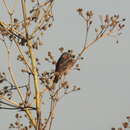Biology
provided by Arkive
Although normally active during the day, the male may sing at night during the breeding season, as he tries to attract females and defend his territory. When singing, the male chooses a prominent spot, points his beak vertically and ruffles his feathers. He will also fight with and chase away other males. Whilst thought to be mainly monogamous, grey-and-chestnut seedeaters are known to mate promiscuously when the population is at a high density. Once laying has taken place, pairs remain faithful; the female incubates the eggs alone, but the male joins her in feeding and caring for the nestlings (4).
The grey-and-chestnut seedeater balances on tall grasses to pick seeds from the seed heads, and consumes no other food (4). It forages in mixed-Sporophila-species flocks of up to 600, but usually around 200 individuals (5).
Conservation
provided by Arkive
The introduction of a total ban on trapping, trading and keeping of this species, and effective enforcement of this ban is important in safeguarding the long-term future of this species. Further research into the range and population size need to be carried out to elucidate the status of the grey-and-chestnut seedeater each year (5).
Description
provided by Arkive
A slender seed-eating finch species, the grey-and-chestnut seedeater has a two-tone body, with grey upperparts and chestnut-brown underparts. The bill, legs and feet are grey.
Habitat
provided by Arkive
Found in marshes, flooded grasslands, pastures and savanna-like areas. It breeds only in low altitude, seasonally wet grasslands (3).
Range
provided by Arkive
The grey-and-chestnut seedeater has scattered populations across north and east Bolivia, southwest Brazil, northeast Argentina and Paraguay. The Bolivian birds are resident, but those in the rest of the range are thought to migrate northwards to Brazil for winter (3).
Status
provided by Arkive
The grey-and-chestnut seedeater is classified as Near Threatened (NT) on the IUCN Red List 2004 (1) and is listed on Appendix I of the Convention on Migratory Species (CMS or Bonn Convention) (2).
Threats
provided by Arkive
The drab colouration of the grey-and-chestnut seedeater does not appear to reduce its allure to the caged-bird trade, in which it is part of a sought-after group of Sporophila species known as the 'cappuccinos' (5).The species is additionally at risk from extensive land use changes across its range. Wet grasslands and marshes are subject to afforestation with pine and eucalyptus trees, although these do not grow well in such wet soil. Mechanised agriculture and cattle-grazing are also responsible for its rapid decline (2).
Rufous-rumped seedeater
provided by wikipedia EN
- license
- cc-by-sa-3.0
- copyright
- Wikipedia authors and editors
Rufous-rumped seedeater: Brief Summary
provided by wikipedia EN
The rufous-rumped seedeater (Sporophila hypochroma), also known as the grey-and-chestnut seedeater, is a species of bird in the family Thraupidae. It breeds in southern Paraguay, Argentina, and Uruguay. It migrates northward to Bolivia, the Pantanal and central Brazil. Its natural habitats are dry savanna, subtropical or tropical seasonally wet or flooded lowland grassland, and pastureland. It is threatened by habitat loss.
- license
- cc-by-sa-3.0
- copyright
- Wikipedia authors and editors

